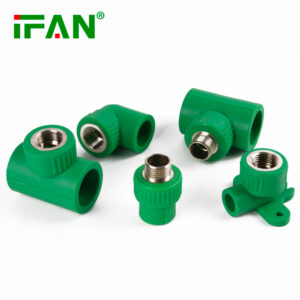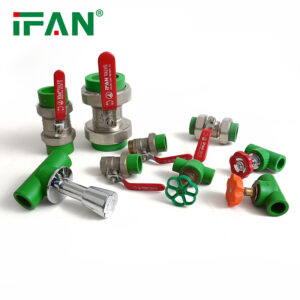Description
IFAN factory 30+ years manufacture experience support color /size customization support free sample.Welcome to consult for catalog and free samples.This is our Facebook Website:www.facebook.com,Click to watch IFAN’s product video.Compared with Tomex products, our IFAN products from quality to price are your best choice, welcome to buy!
When it comes to plumbing systems, the quality and reliability of the fittings used are crucial for ensuring long-term performance and durability. PPR fittings are increasingly becoming the go-to choice in modern plumbing due to their superior properties such as resistance to corrosion, heat, and chemicals. Whether you’re a professional plumber or a DIY enthusiast, understanding the different types of PPR fittings available and knowing how to choose the right one can make all the difference in creating a durable and efficient plumbing system. This guide will delve into the different types of PPR fittings and offer tips on selecting the right one for your needs.
What Are PPR Fittings?
PPR fittings are made from Polypropylene Random Copolymer (PPR), a durable and flexible material that has gained popularity in both residential and industrial plumbing systems. These fittings are used to join various sections of PPR pipes, providing a secure, leak-free connection. They are commonly used in hot and cold water supply systems, heating systems, and even for irrigation purposes due to their excellent resistance to high temperatures, chemicals, and corrosion.
Types of PPR Fittings
There are several types of PPR fittings, each designed to fulfill a specific function. Understanding the different types and their uses will help you make an informed decision when planning your plumbing system.
1. PPR Elbow Fittings
PPR elbow fittings are used to change the direction of the pipe. These fittings are essential when the plumbing design requires a turn or angle, whether it’s a 90-degree or 45-degree bend. Elbow fittings allow the pipes to navigate corners and obstacles while maintaining the integrity of the water flow. They are available in a variety of sizes to match the diameter of the pipes being used.
– When to Use: Ideal for applications where pipes need to change direction.
– Types: 90° elbow, 45° elbow.
2. PPR Tee Fittings
PPR tee fittings are used to create a branch in the plumbing system. These fittings allow three pipes to connect, enabling a water flow split. Tee fittings are often used in both residential and industrial applications, especially when splitting the water supply into two or more directions is necessary.
– When to Use: Useful for branching water lines into multiple directions.
– Types: Equal tee (for equal diameter pipes) and reducing tee (for connecting pipes of different diameters).
3. PPR Couplings
A PPR coupling is a simple fitting used to join two pipes of the same diameter together. This type of fitting is ideal for extending pipe lengths or repairing a broken or damaged section of the pipe.
– When to Use: When connecting two sections of pipe.
– Types: Straight coupling and reducing coupling (for different pipe sizes).
4. PPR End Caps
PPR end caps are used to seal the end of a pipe. These fittings are particularly useful in situations where a pipe needs to be closed off temporarily or permanently, such as during installation or when a branch line is no longer needed.
– When to Use: To block off the end of a pipe.
– Types: Available in various sizes to match pipe diameters.
5. PPR Reducers
A PPR reducer is used to connect two pipes of different diameters. It helps transition from a larger diameter pipe to a smaller one, ensuring a secure and leak-free connection. These are particularly useful in systems that require the use of pipes with varying sizes.
– When to Use: When different pipe sizes need to be connected.
– Types: Straight reducer and reducing elbow.
6. PPR Union Fittings
PPR union fittings are designed for creating removable connections between pipes. These fittings are commonly used when a temporary connection is needed, allowing for easy disconnection when necessary. They are frequently used in maintenance and repair situations.
– When to Use: When a temporary connection or removable joint is needed.
– Types: Threaded union, flanged union.
7. PPR Ball Valves
PPR ball valves are used to control the flow of water through the system. These fittings feature a ball with a hole in the middle that rotates to either open or close the flow of water. Ball valves are known for their reliability and are easy to operate, making them a popular choice in both residential and commercial plumbing.
– When to Use: To control the flow of water in a piping system.
– Types: Manual and automatic ball valves.
How to Choose the Right PPR Fitting
Selecting the right PPR fitting for your plumbing system is essential to ensure smooth and efficient operation. Here are some key factors to consider:
1. Pipe Size
The most important factor in selecting a fitting is the size of the pipe. Ensure that the fitting you choose matches the diameter of the pipe. Using a fitting that is too small or too large will result in leaks or poor water flow.
2. Type of Application
The type of application will influence the type of fitting required. For example, a residential water supply system may require fewer tees and elbows, whereas an industrial system may need a wider variety of fittings for complex layouts. Consider the number of turns, branches, and sections that your plumbing design requires.
3. Temperature Resistance
Different PPR fittings have varying levels of heat resistance. If your system will carry hot water or be used in a heating system, choose fittings designed for high-temperature applications. Ensure the fittings can withstand temperatures up to 95°C (203°F), which is the standard for hot water systems.
4. Durability
The material of the fitting determines its durability. **PPR fittings** are known for their long lifespan, but ensure that the fittings you select are compatible with the specific conditions of your plumbing system. For instance, in areas with high water pressure or chemical exposure, you may need extra-durable fittings.
5. Ease of Installation
While PPR fittings are known for their ease of installation, consider the method of joining the fittings. Some systems use fusion welding, while others might require threaded or push-fit connections. Choose the installation method that best suits your skills and tools.

Installation Tips for PPR Fittings
– Preparation: Always ensure that pipes and fittings are clean before installation to ensure a secure connection.
– Fusion Process: Use the proper fusion machine or tool to heat the pipe and fitting evenly. Incorrect heating can lead to weak joints and potential leaks.
– Test Connections: After installation, always test the system under pressure to check for leaks. This will ensure that all connections are secure and properly sealed.
Benefits of Using PPR Fittings
1. Corrosion Resistance: PPR fittings are highly resistant to corrosion, making them ideal for systems that carry water with various chemical contents.
2. Heat Resistance: These fittings can withstand high temperatures, which is particularly important for hot water systems and underfloor heating.
3. Long Lifespan: PPR fittings can last for decades, significantly reducing maintenance and replacement costs.
4. Eco-Friendly: PPR fittings are recyclable, making them an environmentally responsible choice.
Frequently Asked Questions (FAQ)
1. Can PPR fittings be used for gas pipes?
No, PPR fittings are not suitable for gas lines. They are designed for water and some chemical systems.
2. How long do PPR fittings last?
When properly installed, PPR fittings can last up to 50 years or more.
3. Can PPR fittings be used in cold weather?
Yes, PPR fittings work well in cold weather conditions, but it’s important to insulate the pipes to prevent freezing.
4. How do you install PPR fittings?
PPR fittings are typically welded or fused using a fusion machine. The pipe ends and fitting are heated and then pressed together to form a secure, leak-proof connection.
5. Are PPR fittings safe for drinking water?
Yes, PPR fittings are safe for drinking water as they do not release harmful chemicals into the water supply.
Conclusion
Understanding the different types of PPR fittings and how to choose the right one for your plumbing project is key to ensuring a long-lasting, efficient system. With their durability, resistance to high temperatures, and ease of installation, PPR fittings provide a reliable solution for both residential and commercial plumbing needs. Whether you’re working on a small renovation or a large industrial project, selecting the correct PPR fitting can make all the difference in achieving a high-performance, leak-free plumbing system.
Related products
-
PPR Fittings
Versatile Brass Fittings for All Your Plumbing Needs
-
PPR Fittings
Green PPR Plastic Fittings
-
PPR Fittings
PPR Material Pipe Fittings












